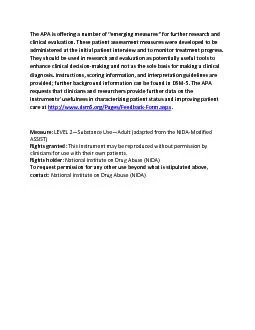

clinical evaluation These patient assessment measures were developed to be administered at the initial patient interview and to monitor treatment progress They should be used in research and evalu ID: 831377
Download Pdf The PPT/PDF document "The APA is offering a number of “emerg..." is the property of its rightful owner. Permission is granted to download and print the materials on this web site for personal, non-commercial use only, and to display it on your personal computer provided you do not modify the materials and that you retain all copyright notices contained in the materials. By downloading content from our website, you accept the terms of this agreement.
The APA is offering a number of “emerg
The APA is offering a number of “emerging measures” for further research and clinical evaluation. These patient assessment measures were developed to be administered at the initial patient interview and to monitor treatment progress. They should be used in research and evaluation as potentially useful tools to enhance clinical decision-making and not as the sole basis for making a clinical diagnosis. Instructions, scoring information, and interpretation guidelines are provided; further background information can be found in DSM-5. The APA requests that clinicians and researchers provide further data on the instruments’ usefulness in characterizing patient status and improving patient care at http://www.dsm5.org/Pages/Feedback-Form.aspx. Measure: LEVEL 2—Substance Use—Adult (adapted from the NIDA-Modified ASSIST) Rights granted: This Instrument may be reproduced without permission by clinicians for use with their own patients. Rights holder: National Institute on Drug Abuse (NIDA) To request permission for any other use beyond what is stipulated above, contact: National Institute on Drug Abuse (NIDA) LEVEL 2—Substance Use—Adult* *Adapted from the NIDA-Modified ASSIST Name: ____________________________ Age: ____ Sex: Male Female Date:_______________ If the measure is being completed by an informant, what is your relationship with the individual receiving care? ______________ In a typical week, approximately how much time do you spend with the individual receiving care? ________________ hours/week Instructions: On the DSM-5 Level 1 cross-cutting questionnaire that you just completed, you indicated that during the past 2 weeks you (the individual receiving care) have been bothered by “using medicines on your own without a doctor’s prescription, or in greater amounts
or longer than prescribed, and/or using
or longer than prescribed, and/or using drugs like marijuana, cocaine or crack, and/or other drugs” at a slight or greater level of severity. The questions below ask how often you (the individual receiving care) have used these medicines and/or substances during the past 2 weeks. Please respond to each item by marking ( or x) one box per row. During the past TWO (2) WEEKS, about how often did you use any of the following medicines ON YOUR OWN, that is, without a doctor’s prescription, in greater amounts or longer than prescribed? Clinician Use Not at all One or two days Several days More than half the days Nearly every day Item Score a. Painkillers (like Vicodin) 0 1 2 3 4 b. Stimulants (like Ritalin, Adderall) 0 1 2 3 4 c. Sedatives or tranquilizers (like sleeping pills or Valium) 0 1 2 3 4 Or drugs like: d. Marijuana 0 1 2 3 4 e. Cocaine or crack 0 1 2 3 4 f. Club drugs (like ecstasy) 0 1 2 3 4 g. Hallucinogens (like LSD) 0 1 2 3 4 h. Heroin 0 1 2 3 4 i. Inhalants or solvents (like glue) 0 1 2 3 4 j. Methamphetamine (like speed) 0 1 2 3 4 Total Score: Courtesy of National Institute on Drug Abuse. This Instrument may be reproduced without permission by clinicians for use with their own patients. Courtesy of National Institute on Drug Abuse. This material may be reproduced without permission by clinicians for use with their own patients. Instructions to Clinicians The DSM-5 Level 2—S
ubstance Use—Adult is an adapted ve
ubstance Use—Adult is an adapted version of the NIDA-Modified ASSIST. The 15-item measure is used to assess the pure domain of prescription medicine, and illicit substance use in adults age 18 and older. It is completed by the individual prior to a visit with the clinician. If the individual receiving care is of impaired capacity and unable to complete the form (e.g., an individual with dementia), a knowledgeable informant may complete the measure. Each item asks the individual receiving care (or informant) to rate the severity of the individual’s use of various substances during the past 2 weeks. Scoring and Interpretation Each item on the measure is rated on a 5-point scale (i.e., 0=not at all; 1=1 or 2 days; 2=several days; 3=more than half the days; 4=nearly every day). The clinician is asked to review the score of each item on the measure during the clinical interview and indicate the raw score for each item in the section provided for “Clinician Use.” Scores on the individual items should be interpreted independently because each item inquires about the use of a distinct substance. The rating of multiple items at scores greater than 0 indicates greater severity and complexity of substance use. Frequency of Use To track change in the severity of the individual’s use of alcohol, tobacco/nicotine, prescription or illicit substance over time, the measure be may completed at regular intervals as clinically indicated, depending on the stability of the individual’s symptoms and treatment status. For individuals of impaired capacity, it is preferred that completion of the measures at follow-up appointments is by the same knowledgeable informant. Consistently high scores on the measure may indicate significant and problematic areas that might warrant further assessment, treatment, and follow-up. Your clinical judgment should guide your decision